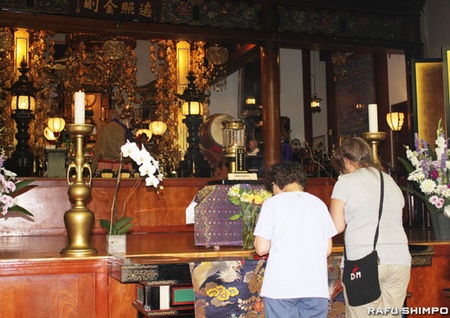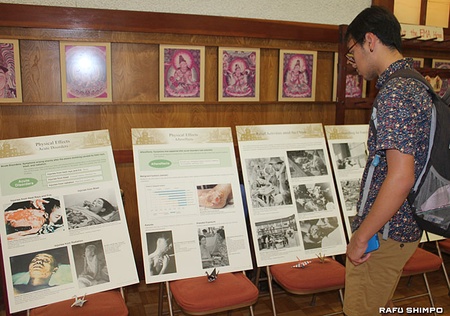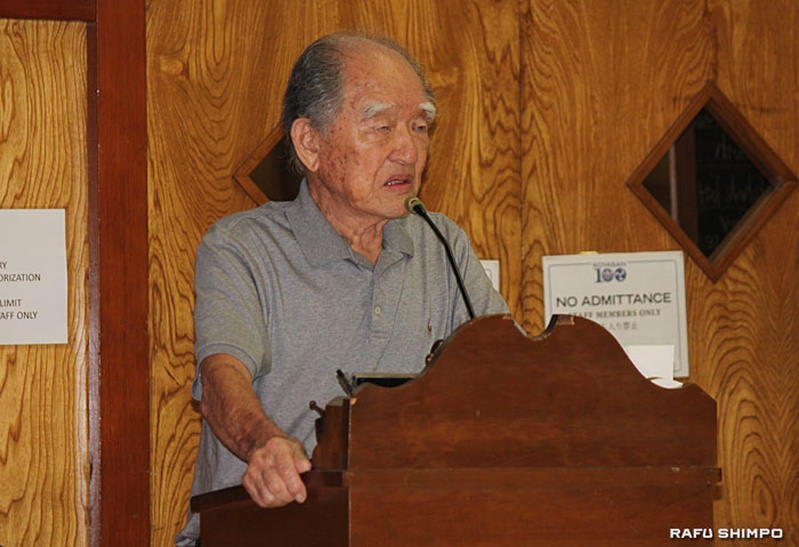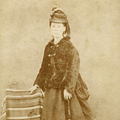Memorial service for the victims of the atomic bombs in Hiroshima and Nagasaki
On the 4th, a memorial service for the victims of the atomic bombs of Hiroshima and Nagasaki was held at Koyasan Betsuin in Little Tokyo. The tragic experiences of the victims and the scars burned into their hearts. At the memorial service, there were people who were actually victims of the atomic bomb in Hiroshima. We listened to their voices as they passed on their experiences to the next generation and prayed for peace.
* * * * *
In 1945, in the midst of World War II, the United States dropped atomic bombs on Hiroshima on August 6th and on Nagasaki three days later on the 9th. The atomic bombs instantly burned down not only buildings but entire cities, taking the lives of many people. By the end of December that year, it is estimated that 140,000 people had died in Hiroshima and over 70,000 in Nagasaki.
Furthermore, people continued to suffer from the aftereffects of the atomic bomb. According to the Hiroshima City government, the number of leukemia patients increased about five or six years after the bombing, and the incidence of malignant tumors began to rise after 1955.
175 atomic bomb survivors in the LA area, aging population, and hopes for peace
The memorial service was attended by members of the American Association of Hiroshima and Nagasaki Atomic Bomb Survivors (ASA) and other community members. They prayed for the repose of the souls of the victims. Among them was Junji Sarashina (90), who is also a survivor of the atomic bombing.
Sarashina, who lives in Orange County, is also the president of ASA. According to Sarashina, there are currently about 175 A-bomb survivors in the Los Angeles area. Four years ago there were more than 300 members, but as they age, many of them are finding it difficult to participate in activities. "We don't know whether it's radiation sickness or illnesses that come with old age," he said, but added, "Many of our members are suffering from leukemia and cancer."
ASA is not limited to the Japanese community, but also speaks to the next generation of young people through lectures at universities and other venues, conveying the experience of the atomic bombing and appealing for peace. Two years ago, in 2017, Sarashina visited Hiroshima and spoke to students, exchanging opinions with 16- and 17-year-old students.

Sarashina's experience of the atomic bombing: "It was like walking through hell"
"It was like seeing the sunlight. I still vividly remember when the atomic bomb was dropped. I saw it all right before my eyes."
Sarashina is a second-generation Japanese American born in Hawaii. His father was a priest at a temple in Aki-Takata, Hiroshima Prefecture, and was a first-generation Japanese immigrant to Hawaii.
"When I was seven or eight years old, my eldest brother had to learn Japanese to take over the temple, so my father, who was a monk, stayed at Honganji Temple in Honolulu, and the rest of the family went to Japan," Sarashina said. At the time of the attack on Pearl Harbor, Sarashina's father, who was a community leader, was arrested by the Federal Bureau of Investigation (FBI) on the same day. "I heard that my father was one of the first to be taken, spent four years in an internment camp, and was one of the last to be liberated."
On August 6, 1945, when the atomic bomb was dropped, Sarashina was 16 years old and living in Hiroshima to study Japanese. He was a mobilized student working at the Asahi Ordnance Factory in Minamikannon-machi when the bomb was dropped about two miles (3.2 km) from the hypocenter. There was no explosion sound, but the force of the explosion hit him as soon as he saw the light.
"If I had taken two steps outside the building sooner, I would have been directly exposed to the orange light. I probably would have lost my life." The building collapsed, and Sarashina lost consciousness for a moment, but fortunately he was not injured.
Hiroshima was burning, and the smoke was so thick it was impossible to see in front of me. I saw many injured people and dead bodies. "It was like I was walking through hell. It was strange to be alive. I was just walking through a scene where death was the norm."
The next day, when he went to his old junior high school, he found a younger student in the pool. He asked, "Do you want to get out of the water?" and she answered, "Yes." So he tried to rescue the younger student, but all that came out was his skin. "Because he was burned, the skin just came off. All I could get my hands on was his skin."
The scene that day was quintessential hell for Sarashina. But strangely enough, he says, his "will to live" was incredibly strong. "I acted without emotion. I became someone who wasn't frightened by anything I saw. That may be the reaction of someone who has seen extremely horrible conditions."
After the war, he was drafted to the United States and served in the Korean War.
"It took me a while to become the person I was before," he says. Even now, at age 90, he still remembers those days. "But I have to take it one step at a time. If I keep thinking about the past, I'll never make any progress," he says.
After the war ended, he returned to Hawaii, and when the Korean War began, he was called up and assigned to the U.S. Army Intelligence Service (MIS). "I was shocked. I thought, 'Why should I have to go?' but then I realized, 'I have no choice.'"
His father was sent to a concentration camp, one of his brothers, a university student, was drafted into the Japanese Navy to train kamikaze pilots, and the other brother was drafted into the Japanese Army and sent to Manchuria, and after the war was taken prisoner by the Russian army and sent to Siberia. Sarashina himself was exposed to the atomic bomb in Hiroshima, and when he returned to the United States he was forced to join the U.S. Army that dropped the atomic bomb. The Sarashina family was engulfed in the great whirlpool of war, and each member of the family faced and fought the difficulties that stood in their way in different places.
Did he have any anger toward America? "Rather than anger, humans adapt easily. A lot of people died in the atomic bombing. It's natural to feel resentment. But in the world our grandchildren will be growing up in, I feel a stronger desire to be flexible and live with the people around us," he says.
At the same time, he emphasizes that it is necessary to convey the horrible suffering and deaths of the many people who died in the atomic bombing. "We should not wage war. As I talk about my experience of the atomic bombing now, I think we need to pass on the suffering of the survivors and those who are still suffering today," he says emphatically.
As of the end of March this year, the number of atomic bomb survivors in Japan who hold the Atomic Bomb Survivor's Health Booklet fell below 150,000 for the first time to 145,444. The average age is 82.65 years old. As the population ages and fewer people are willing to share their experiences, Sarashina and others continue to share their experiences in the United States and appeal for world peace. What is the message that the atomic bomb survivors are asking us? In the second part, we will hear the experiences of third-generation Japanese Americans.

*This article is reprinted from The Rafu Shimpo (August 16, 2019).
© 2019 Junko Yoshida / The Rafu Shimpo






